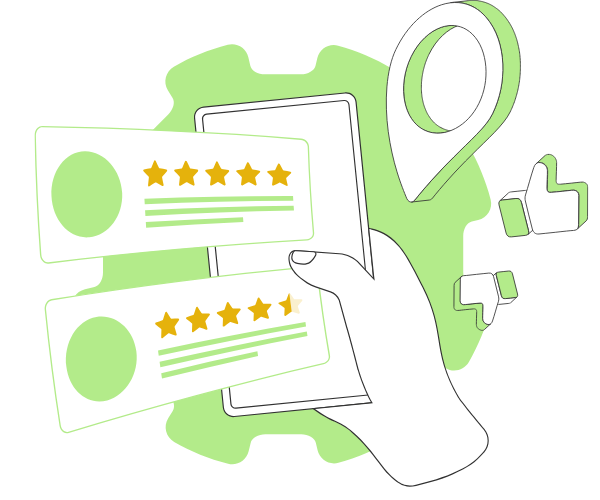Content Search Engine Optimization-Content SEO
25M+
Monthly Organic Visitors
475+
SEO Case Studies
20M
Ecommerce Transactions
530+
Ecommerce Projects
Content SEO
Well, in the most recent digital age, few things are as important as a content strategy to the success of a website. However, creating content is not sufficient on its own. You are optimizing your content for search engines so that it can be found by the right people and bring valuable traffic to your website. This is where Content SEO (Search Engine Optimization) comes through. Implementing SEO best practices will help your content rank higher on search engine pages (SERPs) and increase visibility and organic traffic.
Embark on a journey of discovery with this ultimate guide. We’ll delve into the basics of content SEO, explore the best practices you need to know, and share pro tips that will keep you engaged and committed to your success.
What is Content SEO?
Local SEO enhances your site for local search engine results. Whether you are a local store or a service-oriented business, appearing in local search results is essential to capturing local customers. If you create a well-planned local SEO strategy, your business will be listed in Google’s Local Pack and Map Pack, and the organic results will attract more visitors or customers to your site and generate leads.

Key Advantages of Content SEO
Impressive SEO Rankings
Optimized content matches with the search engine algorithms that allow your website to rank better for the relevant keywords. The higher your rankings, the more visible your business is to potential customers.
Increased Organic Traffic
Increased Organic Traffic If you do effective content SEO, you will get high-quality traffic without paid ads. Using the right amount of targeted keywords and ensuring that the content is informative helps to attract the perfect audience to your site.
Enhanced User Experience
Visitors spend more time on your content, which leads to a bounce rate and increases your credibility. your online and offline visibility, leading to more visits to your store.
Cost-Effective Marketing
Content SEO, instead of paid ads, delivers consistent results over time, making it a long-term value for your investment. Once optimized, content is used to drive traffic and leads for free.

Why is Content SEO Important?
Search engines (Google, Bing, and Yahoo) send millions of site visitors daily. For companies and content creators, the first-page appearance of search results can lead to marked traffic increases, engagement, and conversions. Most of these experiences start with a search engine query, which is why content SEO matters.
The following are crucial reasons why content SEO is essential:
Higher visibility: Content that ranks high will have a much more significant chance of being seen and read by users.
Traffic: The best part is SEO enables your content to gain organic traffic without paying for ads.
Enhanced User Experience: Effective content optimization is not just catering to search engine spiders. It’s about valuing your users and enhancing their overall experience on your website. By prioritizing user experience, you make your audience feel valued and integral to your content’s success.
Cost-Effective: SEO is a much more permanent solution for driving traffic than paid advertising and at a much lower cost.
Afshan – SEO Expert offering Content SEO Services
Good quality, optimized content is your secret weapon for shining in an ever-competitive digital environment. I am Afshan an expert in Content SEO Bucket Strategies for higher rankings and Organic Traffic.
What Do I Offer in Content SEO Services
Research & Optimize Local Keyword Data
Local companies need to find the right keywords. I perform extensive keyword research to identify local keywords your customers are searching for. I will then enhance your website's content, meta tags, and Google Business Profile (previously Google My Business) to boost your business's ranking in local search results.
Engaging Content Creation
I generate engaging, quality, and SEO-optimized content such as blog posts, articles, landing pages, and product descriptions. Each piece is crafted to align with your brand voice and resonate with your audience.
Meta Tag Optimization
Hence, I write irresistible title tags and meta descriptions to boost your site’s CTR. I also check that all your meta elements work for users and search engines.
Content Audit and Enhancement
To create in-depth audits of your existing content to focus on content gaps and opportunities. Update old content with new data and optimized keywords.
Internal and External Linking Practices
Utilize best practices for internal linking to improve your site's navigability and SEO value. Obtain high-quality backlinks from authoritative websites to enhance your domain authority.
Content That is Localized and Industry-Specific
The News & Updates feed trains you for local SEO-based content. Create Industry-focused content that positions your business as a thought leader.
What Makes Afshan the Best Content SEO Services Provider?
Data-Backed Results
Everything I do is based on solid data, and I have delivered tangible outcomes for various clients across different industries.
Personalized Techniques
Every step of the SEO process differs based on your business goals.
Data-Driven Results
My strategies are issue-based and are aimed at long-term growth using constant evolution.
Absolute Transparency
Regularly report and update you on content performance and SEO efforts.
Results You Can Expect
Improved Search Engine Rankings
This leads to higher placement for your website in search results for specific keywords based on this, consequently, easier accessibility for potential customers to discover you.
Increased Organic Traffic
Optimized content can drive traffic to your site without spending money on advertising.
Improved User Engagement
Relevant content engages users longer, perusing more pages and prolonging their visit while also reducing bounce rate and improving convertibility.
Content SEO: Key Elements Behind Great Content
There are several key components that you must cut your teeth on to truly master content SEO and the way search engines find and rank your content:
Keyword Research
The central pillar of content SEO is keywords that people are searching for. You should incorporate those keywords throughout your content to signal their relevance to the engines.
Instruments
Such as Google Keyword Planner, Ahrefs, and SEMrush can help you discover keywords with decent search volume and little competition.
Content Quality
Search engines rank highly leading, relevant, and quality content in this way. Any great content provides a solution to a problem, answers questions, and gives in-depth info.
Strategic Use of Keywords
Use keywords in titles, headings, first 100 words, and throughout the content. Don't Keyword stuffing harms rankings. Try to use it in a natural and user-friendly way for readers. Add words that are logically connected and have the same meaning and provide variation to your articles.
Mobile-Friendly Content
Make sure content is mobile-friendly. Improve page speed and Ensure fast loading times by optimizing images and compressing files.
Visual Elements and Media
Incorporate Large Visuals, Graphics, images, and videos for more socially engaging content. SEO for Media Name and tag all images with descriptive file names and alt text to help accessibility and rankings.
Content Updates and Audits
Update old content frequently so it remains accurate and relevant. Analysis. Tools such as Google Analytics can also be used for this step, which shows you what is working and what isn't.
Local SEO Integration
Localized Keywords: Include words related to the specific city or area you are targeting Google Business Profile.Connect your content to your local listing to drive better local rankings.
Do not add thin, low-quality content that falls below the ideal value for the user. Instead, produce long-form, comprehensive content that is authoritative in your space.

Content Structure
The organization of your content is a significant factor that helps users navigate and comprehend information better. A good structure makes it easier for humans and search engines to understand your content.
Write descriptive headings (H1, H2, H3, and similar) to organize content. This makes it easier to read and is great for SEO.
On-Page Optimization: On-page SEO refers to the optimizations you can make to individual elements inside your content to increase its probability of ranking. This means using your target keyword in the title tag, meta description, URL, headings, and body text.
Improving interlinking between contextual pages on your website can also improve SEO.
User Engagement: To decide whether your content is valuable, they also consider user engagement metrics, such as time on page, bounce rate, and CTR.
So make blog writing pleasant for reading, design attractive, and navigation easy.
Mobile Optimization: More users visit websites on mobile devices, and search engines favor mobile content. This means your website needs to be completely responsive and optimized.
Page Load Speed: Slow-loading pages can be problematic for user experience and SEO ranking. Use tools like Google PageSpeed Insights to check page load times and optimize your website.
Types of Keywords:
Short-tail keywords
These are general and typically have a significant search volume but are also very competitive.
Long-tail keywords
Long-tail Keywords are more refined terms, often with less competition and a higher conversion potential.
LSI Keywords
LSI keywords are phrases related to your keyword that help provide additional context for your content. For example, the keyword “content marketing” could be LSI keywords “blogging,” “digital marketing,” or “SEO strategy.”
User Intent Focus
Identify if the user intent is of the informational, transactional, navigational, or commercial type and structure content accordingly.
Take care of Featured Snippets.
Featured snippets are the boxed text that appears at the top of some search results. They help users find quick answers and have a very high CTR, which can increase your website’s traffic.
- Write FAQ Sections for Target: Answer common questions clearly and purposefully.
- Use Lists and Tables: Content with structure, such as lists and tables (bullet points), is far more likely to be featured.
- Answer succinctly and directly: If someone searches for something on your site, give them a concise answer.
Focus on Content Readability
The readability makes it easy to read and scan, making the experience more user-friendly and improving your engagement, ultimately contributing to better SEO rankings. Here are some tips:
- Keep Paragraphs Short: Long paragraphs make it hard to read. Make sure your content is implemented in short, bite-sized paragraphs.
- Use Subheadings: Use subheadings to provide structure to your copy and improve SEO
- Use Bullet Points: Bullet points effectuate quick access to critical information.
How To Measure The Success Of Content SEO
- Organic Traffic Growth
- Keyword Rankings
- Bounce Rate
- Time on Page
- Pages Per Session
- Click-Through Rate (CTR)
- Backlinks Generated
- Conversion Rates
- Social Shares and Engagement
- New vs. Returning Visitors
- Indexed Pages
- Revenue or Lead Generation
Content SEO requires balancing extensive keyword research, high-quality content, sound on-page optimization, and an emphasis on user experience. Implementing the tips in this guide can improve your content’s search engine rankings, encourage more natural interactions and engagement with your audience, and drive more traffic.
The impact on SEO isn’t seen immediately, but if you remain patient diligent and strive to optimize consistently, you will see dramatic improvements in your website’s performance. Implement these strategies now, and set your content up for success in the long haul!
FAQs
Use keyword research to determine what terms and phrases are being searched. This will allow you to create content that drives traffic and directly addresses user intent, thus increasing your chances of ranking high in search results.
Adopt relevant keywords, crafted titles, anchor texts, meta descriptions, headlines, content layout, attractive titles, etc.
As the adage goes, quality over quantity. In this regard, longer content generally wins the battle regarding search results. Content should be valuable and not unnecessarily long. Be consistent about quality over quantity.
Good UX is important for SEO. Google and other search engines consider metrics such as how quickly your site loads, whether it is mobile-friendly, and how easy it is to navigate. Good UX retains visitors, decreases bounce rates, and increases rankings.
